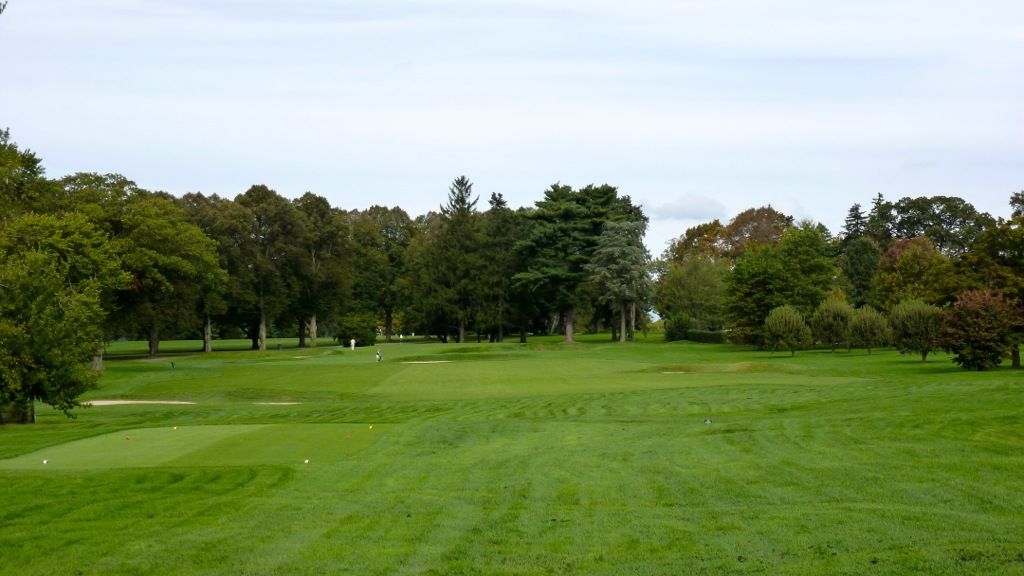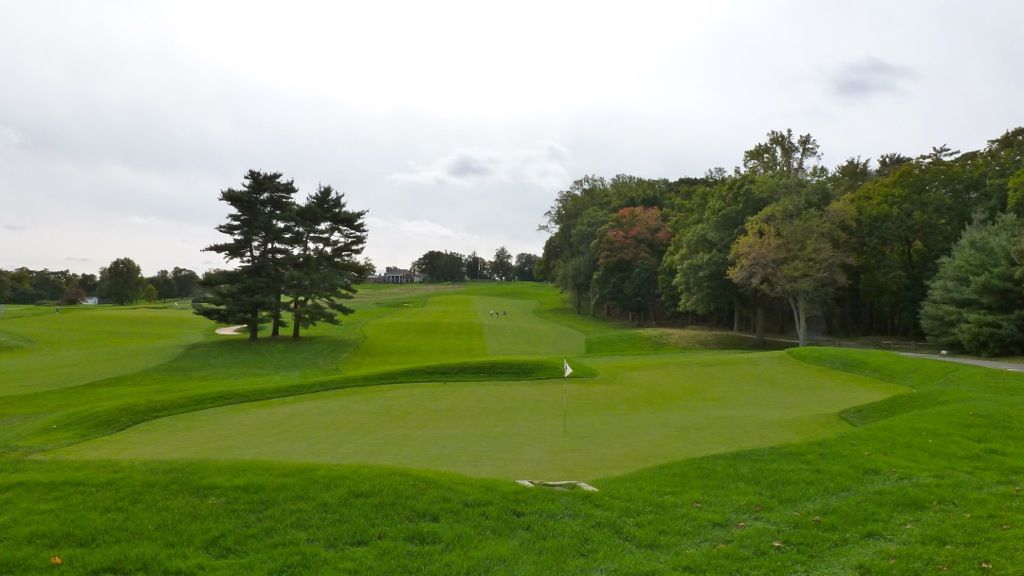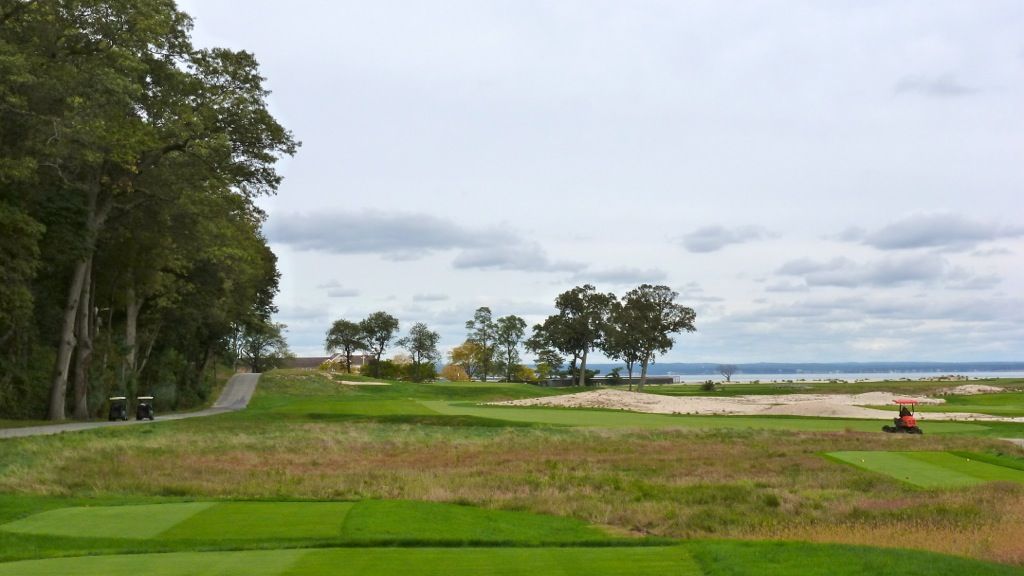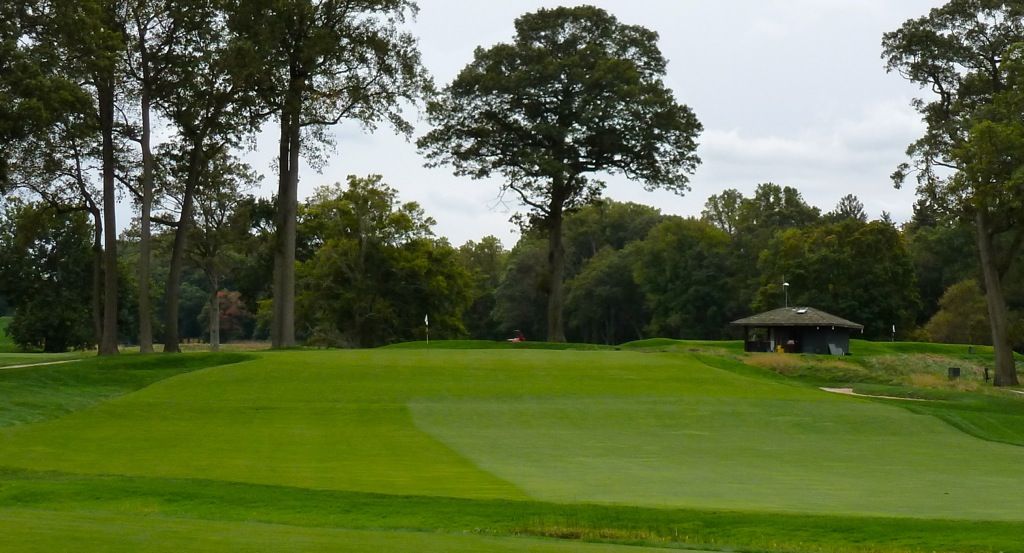Locust Valley, New York, United States
Architect: C.B. Macdonald (1923)
6,459 Yards, Par-70
Rating/Slope: 72.0/136
My Quick Review: Home of the famed island Biarritz; the best holes are the non-templates and there are some great ones!

The Creek (not The Creek Club), designed by Charles Blair Macdonald in 1923, features several of the 'templates' though less than I am used to seeing.
4 is Eden
7 is Long
8 is Redan
11 is Biarritz
13 is Cape
15 is Double Plateau
17 is Short
Without a doubt, the most talked about and most photographed hole on the golf course is the unique island Biarritz 11th. But, in my opinion, the best holes on the golf course are the non-template holes.
The 6th hole transitions the golfer from the upper portion of the property to the lower portion. Aside from the extremely uphill 18th, the 6th is has the most elevation change of any hole on the golf course and features a fascinating green and surrounds. I could try to describe it, but pictures will do a much better job than words.
Scorecard Information

Routing

I suspect that the opening quintet of holes are criticized by many as lacking character, playing over a flat portion of the golf course and routed in a back-and-forth manner.
Nonetheless, the first hole, a mid-length par-4 is subtle, is dangerous, and is an excellent opener. The tee shot is played over a series of top-shot bunkers to a blind driving zone. Tee shots that are not taken on the bold line to the right risk running down a large slope and into the left rough. The photo is taken from the right portion of the fairway, just short of a series of cross-bunkers 100 yards short of the green. The green itself is wonderful, tilting with the land from back-left to front-right. Misses short/left may collect into the left bunker.

The second is a short par-4 with plenty of width, though the narrow green is best approached from the left side of the fairway.

Given the limited square footage of the second green, the amount of contour is almost overwhelming.

The third is easily the most forgettable hole on the course.

The 4th hole is the 174 yard Eden, and it is a very good rendition. The tilt of the green from back-to-front is substantial and Strath is not a place a golfer wants to be (though, better than missing long!)


The 5th is the 4th shortish par-4 of the round, though this hole plays uphill the entire way. An uninteresting tee shot gives way to an interesting 'sunken' green that lay at a 45-degree angle to the fairway. I think tree removal would give way to a wonderful skyline green.

After something of a mundane start, the golfer is stunned with one of the great views in golf and one of the best holes on Long Island. The 6th is a 450 yard par-4 that, despite its length, will play as little more than a driver and a mid-iron as the hole plays straight downhill and the tilt of the fairway should send the ball bounding.

The ideal tee shot will be played down the left side, allowing the golfer to use the ground's contours short of the green. A feeder slope short-left of the green can be used to access back-right pin positions!


The 7th is Long; something of a forgettable par-5 for its first two thirds (both of the first two shots are blind) that gives way to a nice skyline approach, a severely tilted green, and a phenomenal view from the back of the green.

The 8th is Redan, playing about 185 yards, and is a very good example of the template. The short-right bunkering is not as fearsome as I've seen elsewhere, but the kicker and slope of the green and firm conditions ensure that the hole functions as intended.


The 9th is Inferno (not sure why) and is another very good non-template hole. The hole plays well over 400 yards and demands that the golfer take the bold line over fairway bunkers to the narrow portion of the fairway to leave the shorter approach from a preferred angle. Bail-out right and the approach (with a long-iron) will be completely blind, played over a dune.

The green sits atop a rise (maybe that's why it's called Inferno?) and requires an all-carry approach as a series of bunkers / rough protects the front of the green.

The 10th hole brings the golfer near the Beach House and immediately adjacent to Long Island Sound. The golfer is asked how much he dare cut-off, and anything bailed-out left risks a blind approach (at best) or running through the fairway into the dune.


The 11th is the famous island Biarritz. The hole measures 200 yards on the scorecard, but the green is some 80 yards deep. Normal wind is downwind from the right and despite the added length, I was told that golfers beg for a back-pin. The 11th is a very fun hole, even if the swale is not as deep as expected, but I wonder how the hole will play with firm conditions and a strong wind (as I'm sure is common so close to the Sound).



The 12th is a simple, short par-4 and offers a brief reprieve from the brutal stretch that is 11-14.


The 13th is Cape, and at 473 yards into the wind, it is a monster. I was told that over the past several years reeds and the like were removed from the water on the inside of the dogleg. I have little doubt that this has shifted the Line of Instinct and as a result golfers are taking-on a bolder line than is advisable.

A cleverly placed ridge runs along the left side of the fairway short of the green and allows properly shaped shots to run onto the green.

The 14th is another brute of a par-4. The Line of Instinct will have golfers playing farther right than there is fairway(!), so one must hope to have a good caddie to steer the golfer in the right direction. A stream crosses the fairway 270 yards from the tee, requiring longer hitters to hit less than driver.

A fearsome approach played uphill, downwind to a green with a massive false-front. Any ball landing on the first 1/4 of the green will funnel some 30 yards back down the fairway. No simple recovery, either.

The 15th is a very fun hole -- a Hog's Back / Double Plateau combination. The tee shot is played uphill to a very tilted fairway. A bold tee shot will be played toward the sliver of fairway right of a centreline bunker, leaving a level approach from a level lie. Bailing left will leave a very difficult pitch...

as fairway grass short of the green will repel shots hit short and the green's contours will more readily accept an approach from the right.

The 16th is the final par-4 on the course, and it plays alongside a centuries old cemetery. Once again the golfer must fight the Line of Instinct as tee shots on the inside of the dogleg may find fairway bunkering / rough. Another false-front guards the 16th green.


The 17th is Short, and is not the best example I've seen. Unlike the Shorts at Fishers Island, National, or Sleepy Hollow, which feature very LARGE greens with wonderful contouring, the Short at The Creek is a small and simple green that is gently bunkered.

If nothing else, the 18th hole will test a golfer's fitness. The entire drop of the 6th hole is recovered on the very uphill, 450 yard par-5 18th. A series of bunkers are staggered left and right along the fairway, generally flanking the driving zone and the area 100 yards short of the green. The arbitrary mowing lines and narrowing of the fairway bother me (this is not done anywhere else on the golf course) and I suspect are a way to help protect par on this short hole.

The green is large and has the most internal contour of any green on the golf course. Another way to protect par. An interesting green, though I'm not sure it fits.


No comments:
Post a Comment